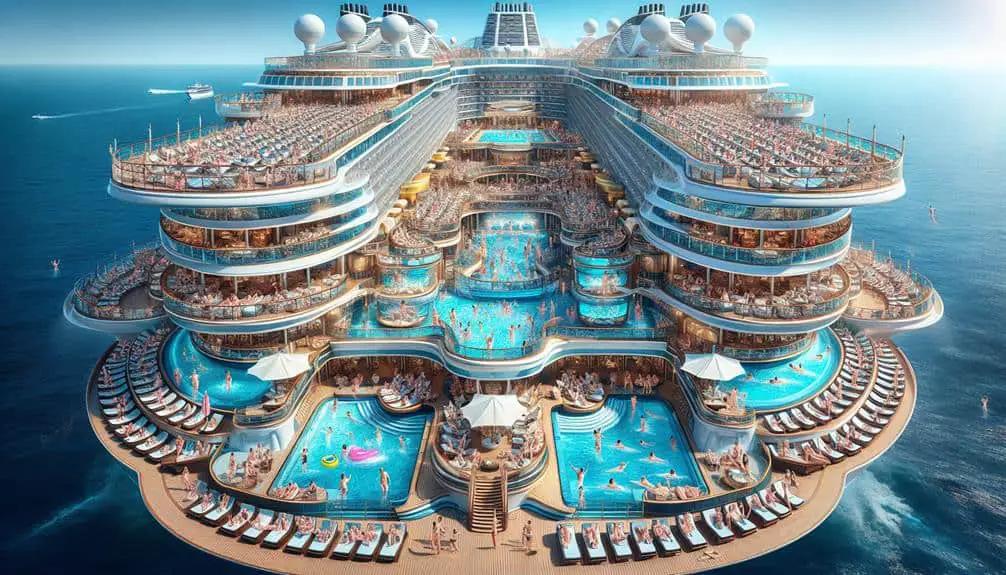Cabin sizes on cruise ships vary due to space usage, ship design, layout, and essential rules. Larger ships offer more space, flexibility, and varied layouts compared to smaller vessels. Balancing capacity and comfort is critical, done through smart furniture arrangement and ergonomic design. Considerations like passenger needs and efficient space use play a role in cabin allocation. Understanding these factors provides insights into why cabin sizes differ on cruise ships.
Key Points
- Space utilization impacts cabin size diversity on cruise ships.
- Ship design maximizes space efficiency, influencing cabin sizes.
- Structural limitations and safety regulations affect cabin size and layout.
- Ship size determines cabin layout, with larger ships allowing for more flexibility.
- Balancing capacity with comfort is crucial for optimizing passenger satisfaction.
Factors Influencing Cabin Size Variation
When considering cabin sizes on cruise ships, various factors play an important role in determining the extent of variation. Space utilization is a key factor affecting cabin size diversity. Cruise ships are designed to maximize space efficiency, leading to variations in cabin sizes. The layout of the ship, including the number of cabins on each deck, impacts the available space for individual cabins. Structural limitations also influence cabin sizes to a great extent. The ship's architecture and design must adhere to strict safety regulations, affecting the size and layout of cabins.
Space utilization is optimized by cleverly arranging cabins to make the most of the available area. The challenge lies in balancing the comfort of passengers with the need to accommodate a certain number of cabins within the ship's structure. Structural limitations such as weight distribution, load-bearing capacities, and safety requirements all contribute to the range of cabin sizes available on a cruise ship. Understanding these factors is important for cruise ship designers to create comfortable and functional living spaces for passengers while adhering to strict structural guidelines.
Impact of Ship Size on Cabins
The magnitude of a cruise ship profoundly influences the layout and distribution of cabins onboard, impacting the overall passenger experience and comfort. Larger ships tend to have more space to allocate for cabins, allowing for greater space efficiency in cabin design. Architectural limitations, such as the width and height of the ship, play a vital role in determining the size and layout of cabins.
On larger ships, there's often more flexibility in cabin sizes and configurations due to the abundance of space available. Designers can prioritize space efficiency by incorporating innovative storage solutions and maximizing the use of available square footage. However, architectural limitations can constrain the size and layout options on smaller ships, leading to more standardized cabin sizes and layouts.
Considering space efficiency and working within architectural limitations are essential factors in determining cabin sizes on cruise ships. Designers must balance the need for comfort and functionality with the constraints imposed by the ship's size and structure to provide passengers with a satisfying onboard experience.
Balancing Capacity With Comfort
To optimize passenger satisfaction, cruise ship designers must meticulously balance cabin capacity with comfort, ensuring a harmonious onboard experience for all travelers. This delicate equilibrium involves strategic space utilization and ergonomic design principles.
Space utilization plays a critical role in cabin layout, with designers maximizing available square footage to accommodate a specified number of passengers without compromising comfort. By efficiently arranging furniture, storage solutions, and amenities, cabins can feel spacious and functional despite their size constraints.
Ergonomic design further enhances passenger comfort by prioritizing usability and efficiency within the cabin space. Every element, from the placement of beds and seating areas to the design of bathrooms and storage compartments, is carefully considered to promote ease of movement and convenience for guests. By incorporating ergonomic principles, such as optimizing sightlines, minimizing clutter, and ensuring adequate lighting, cruise ship cabins can offer a comfortable retreat for travelers to relax and rejuvenate during their voyage.
Achieving this balance between capacity and comfort is essential for creating a positive onboard experience for all passengers.
Design Considerations for Cabin Sizes
Balancing cabin capacity with comfort on cruise ships involves meticulous consideration of design considerations for cabin sizes. Space utilization is a critical factor in determining cabin sizes. Efficient use of space is achieved through smart cabin layout design, ensuring that every inch serves a purpose. Ergonomic layout plays a key role in maximizing the functionality of the cabin. By strategically placing furniture, amenities, and storage options, the cabin can feel more spacious and comfortable.
When designing cabin sizes, cruise ship architects prioritize ergonomic layouts to enhance the overall guest experience. This involves thoughtful placement of beds, seating areas, and storage solutions to optimize comfort and convenience. Additionally, maximizing space utilization allows for the inclusion of important amenities without compromising on roominess. By carefully planning the layout of each cabin, cruise lines can offer guests a comfortable and functional living space during their voyage.
Passenger Preferences and Cabin Allocation
Considering passenger preferences and cabin allocation is vital for optimizing the cruise ship experience. Passenger satisfaction hinges on providing accommodations that meet their needs and expectations. When it comes to cabin allocation, cruise lines must balance various factors, such as cabin size, location, and amenities, to guarantee an enjoyable voyage for all guests.
Space utilization plays a critical role in cabin allocation. Cruise ships have limited space, requiring efficient use to accommodate a large number of passengers. Allocating cabins based on passenger preferences for size, location, and additional features can enhance overall satisfaction. For instance, some passengers may prioritize a larger cabin size, while others may prefer a cabin closer to amenities like dining areas or entertainment venues.
Frequently Asked Questions
How Do Cruise Lines Determine the Pricing of Cabins With Different Sizes?
To determine pricing for cabins of varying sizes, cruise lines employ strategic pricing strategies based on demand, amenities, and location. Cabin upgrades often come at a premium, reflecting a combination of luxury offerings and supply-demand dynamics.
Are There Any Regulations or Standards That Dictate the Minimum Size of Cruise Ship Cabins?
Regulations and industry standards govern cabin layout and size on cruise ships. Factors like safety requirements and design considerations influence the minimum size of cabins. These guidelines guarantee comfort and compliance with maritime regulations.
Can Passengers Request to Switch to a Different Cabin Size Once Onboard the Cruise Ship?
Seeking cabin upgrades for increased passenger satisfaction? While onboard, you can request a different cabin size based on availability and payment. Contact Guest Services promptly to inquire about switching and enhancing your cruise experience.
Are There Any Special Accommodations Available for Passengers With Disabilities in Cabins of Varying Sizes?
Accessible accommodations on cruise ships cater to passengers with disabilities. Cabins of varying sizes can accommodate mobility aids. Notify the cruise line in advance to guarantee suitable arrangements. Enjoy your cruise with comfort and ease.
How Do Cruise Lines Ensure That All Passengers Have Equal Access to Amenities and Facilities Regardless of Cabin Size?
To guarantee equal access to amenities, cruise lines offer various accessibility options like wheelchair-friendly cabins and facilities. Cabin allocation is strategic, with priority given to those needing special accommodations, ensuring a fair experience for all passengers.




